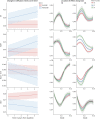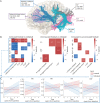Microstructural Alterations in Tract Development in College Football and Volleyball Players: A Longitudinal Diffusion MRI Study
- PMID: 37479529
- PMCID: PMC10501097
- DOI: 10.1212/WNL.0000000000207543
Microstructural Alterations in Tract Development in College Football and Volleyball Players: A Longitudinal Diffusion MRI Study
Abstract
Background and objectives: Repeated impacts in high-contact sports such as American football can affect the brain's microstructure, which can be studied using diffusion MRI. Most imaging studies are cross-sectional, do not include low-contact players as controls, or lack advanced tract-specific microstructural metrics. We aimed to investigate longitudinal changes in high-contact collegiate athletes compared with low-contact controls using advanced diffusion MRI and automated fiber quantification.
Methods: We examined brain microstructure in high-contact (football) and low-contact (volleyball) collegiate athletes with up to 4 years of follow-up. Inclusion criteria included university and team enrollment. Exclusion criteria included history of neurosurgery, severe brain injury, and major neurologic or substance abuse disorder. We investigated diffusion metrics along the length of tracts using nested linear mixed-effects models to ascertain the acute and chronic effects of subconcussive and concussive impacts, and associations between diffusion changes with clinical, behavioral, and sports-related measures.
Results: Forty-nine football and 24 volleyball players (271 total scans) were included. Football players had significantly divergent trajectories in multiple microstructural metrics and tracts. Longitudinal increases in fractional anisotropy and axonal water fraction, and decreases in radial/mean diffusivity and orientation dispersion index, were present in volleyball but absent in football players (all findings |T-statistic|> 3.5, p value <0.0001). This pattern was present in the callosum forceps minor, superior longitudinal fasciculus, thalamic radiation, and cingulum hippocampus. Longitudinal differences were more prominent and observed in more tracts in concussed football players (n = 24, |T|> 3.6, p < 0.0001). An analysis of immediate postconcussion scans (n = 12) demonstrated a transient localized increase in axial diffusivity and mean/radial kurtosis in the uncinate and cingulum hippocampus (|T| > 3.7, p < 0.0001). Finally, within football players, those with high position-based impact risk demonstrated increased intracellular volume fraction longitudinally (T = 3.6, p < 0.0001).
Discussion: The observed longitudinal changes seen in football, and especially concussed athletes, could reveal diminished myelination, altered axonal calibers, or depressed pruning processes leading to a static, nondecreasing axonal dispersion. This prospective longitudinal study demonstrates divergent tract-specific trajectories of brain microstructure, possibly reflecting a concussive and repeated subconcussive impact-related alteration of white matter development in football athletes.
© 2023 American Academy of Neurology.
Conflict of interest statement
M. Zeineh receives research funding from GE Healthcare. All other authors report no disclosures relevant to the manuscript. Go to
Figures





Comment in
-
Mind Your Head: Insights Into Brain White Matter Tract Maturation in Collegiate Athletes.Neurology. 2023 Aug 29;101(9):380-381. doi: 10.1212/WNL.0000000000207775. Epub 2023 Jul 21. Neurology. 2023. PMID: 37479528 No abstract available.
Similar articles
-
Investigating Brain White Matter in Football Players with and without Concussion Using a Biophysical Model from Multishell Diffusion MRI.AJNR Am J Neuroradiol. 2022 Jun;43(6):823-828. doi: 10.3174/ajnr.A7522. Epub 2022 May 19. AJNR Am J Neuroradiol. 2022. PMID: 35589140 Free PMC article.
-
Longitudinal alteration of cortical thickness and volume in high-impact sports.Neuroimage. 2020 Aug 15;217:116864. doi: 10.1016/j.neuroimage.2020.116864. Epub 2020 Apr 29. Neuroimage. 2020. PMID: 32360690
-
White matter alterations in college football players: a longitudinal diffusion tensor imaging study.Brain Imaging Behav. 2018 Feb;12(1):44-53. doi: 10.1007/s11682-017-9672-4. Brain Imaging Behav. 2018. PMID: 28092023
-
Characterizing the Effect of Repetitive Head Impact Exposure and mTBI on Adolescent Collision Sports Players' Brain with Diffusion Magnetic Resonance Imaging.J Neurotrauma. 2025 Mar;42(5-6):349-366. doi: 10.1089/neu.2024.0064. Epub 2024 Dec 23. J Neurotrauma. 2025. PMID: 39714998
-
Longitudinal Changes in Hippocampal Subfield Volume Associated with Collegiate Football.J Neurotrauma. 2019 Oct 1;36(19):2762-2773. doi: 10.1089/neu.2018.6357. Epub 2019 Jun 17. J Neurotrauma. 2019. PMID: 31044639 Free PMC article.
Cited by
-
White Matter Hyperintensities and Microstructural Alterations in Contact Sport Athletes from Adolescence to Early Midlife.J Neurotrauma. 2024 Oct;41(19-20):2307-2322. doi: 10.1089/neu.2023.0609. Epub 2024 May 9. J Neurotrauma. 2024. PMID: 38661548
-
Assessment of white matter microstructure integrity in subacute postconcussive vestibular dysfunction using NODDI.Imaging Neurosci (Camb). 2024;2:imag-2-00147. doi: 10.1162/imag_a_00147. Epub 2024 Apr 10. Imaging Neurosci (Camb). 2024. PMID: 40746965 Free PMC article.
References
Publication types
MeSH terms
LinkOut - more resources
Full Text Sources
Medical
